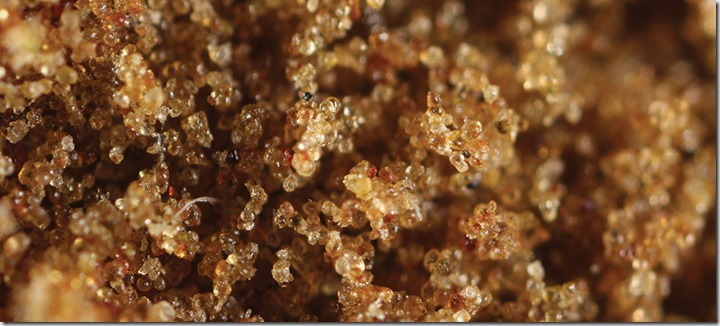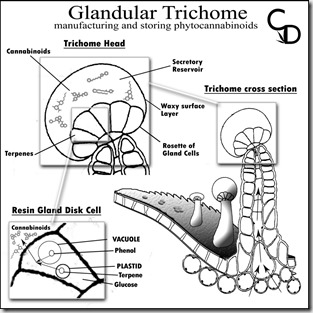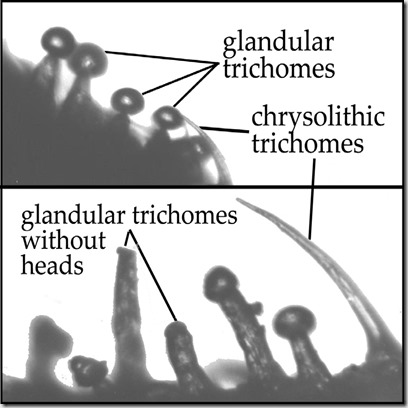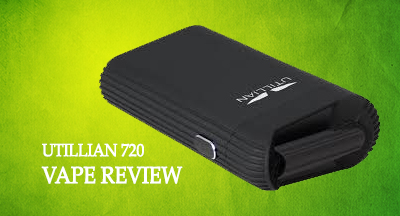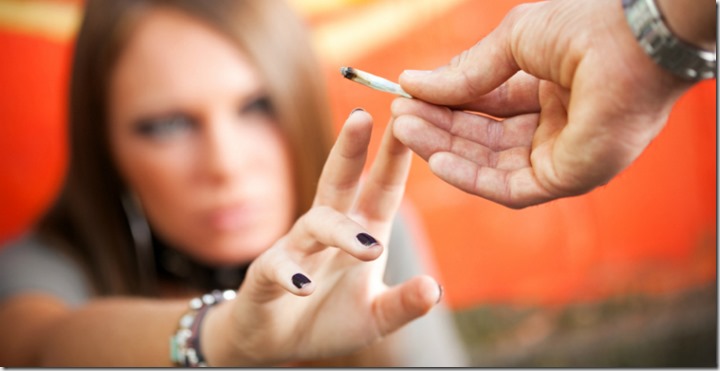(image: bubbleman fresh headies)
By Owen Smith
Our key expert witness during the extract trial in 2012 was Dr. David Pate. His expertise in cannabis botany would help the court understand how and where the cannabis plant produces its’ medicinal compounds. This would help us show that the restriction to dried marihuana is arbitrary and even counter-productive to those using it for medicinal purposes.
Dr. Pate explained that while the chemical precursors for the creation of cannabinoids are absorbed through the roots from the soil and are found throughout the plant, cannabinoids and terpenes are manufactured within the trichomes by a rosette of cells at the base of each trichome head. “The glandular trichomes […] are characterized by a secretory disc of one to 13 cells supported by a layer of stipe cells above a layer of base cells embedded in the epidermis. The secretory cells of mature glandular trichomes produce a resinous fluid which accumulates beneath a membranous sheath.” [transcripts]
The “membranous sheath” of the trichome is composed of a waxy cellulose that has no therapeutic value, other than acting as a container for the resin prior to and during the act of extraction into fat, alcohol, solvents, or fatty bodily fluids. Trichomes occur at various sizes and stages of maturity, in greater amounts nearer the top of the plant on the flowering buds.
For ease of reference Dr. Pate compared the trichome to a golf ball on a tee. At the base of the tee components required for the production of cannabinoids are transported from the plant up the tee and are transformed as they enter the golf ball on top. The structure of the trichome with its thin neck makes it easy for the trichome heads, swollen with medicinal compounds, to fall off. Shaking the plant over a screen will easily separate the trichomes, producing a form of dry sift hash.
Dr. Pate explained that unlike the trichome heads, the dried plant matter may contain heavy metals, fertilizer residue, pesticides and moulds. Plant matter is composed of non-digestible cellulose which, while not harmful, may be contra-indicated for persons with gastro-intestinal conditions. He concluded that the dried plant matter has no medical utility apart from being a vehicle to carry the medical compounds prior to extraction; except during smoke inhalation as the cellulose provides the fuel for the superheated ember at the end of a doobie.
He explained that there are micro-abrasive silicified cystolithic trichomes all over the plant’s surface. These sturdier thorn shaped trichomes contain a little crystal of unpalatable oxalic acid at their base and act as the plant’s self defence against hungry animals. Due to the structural difference between the two kinds of trichome, simple extraction techniques can separate the medicine held in the glands from the deterrent cystoliths.
Health Canada’s insistence on including the plant material and cystolithic trichomes in medicinal cannabis products serves no clear purpose and persists at the expense of patients health. Justice Johnston ended up including a large section of Dr. Pate’s testimony in his final decision. On April 13th 2012, patients in British Columbia were immediately permitted to create their own medical cannabis extract products. While this was a victory for patients, the Judge decided that I should still undergo a criminal trial because I am not a patient. We selected a trial by Jury that was scheduled for one year later.
previously appeared at LiftCannabis

